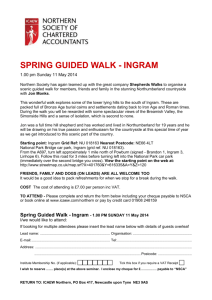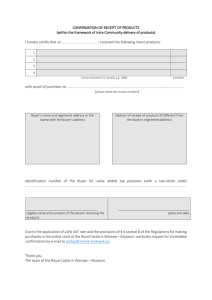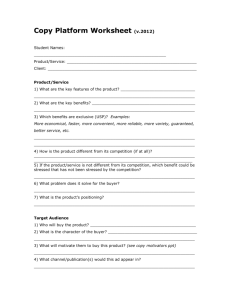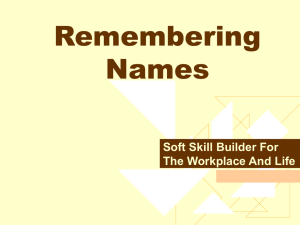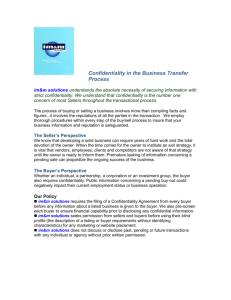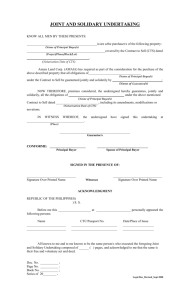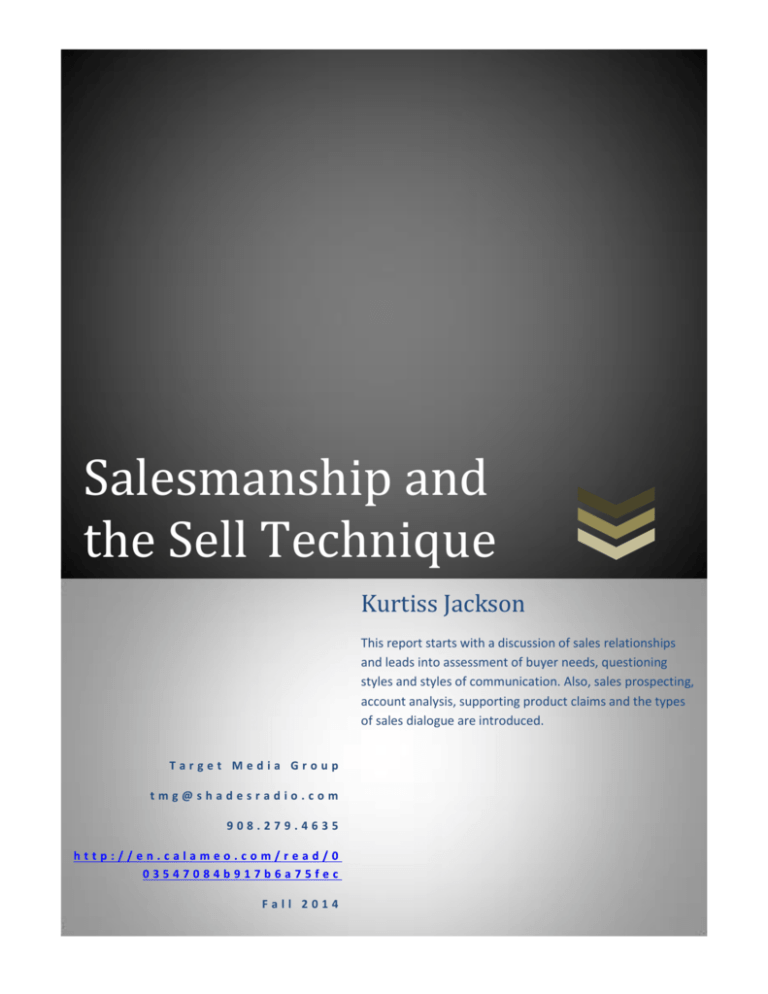
Salesmanship and
the Sell Technique
Kurtiss Jackson
This report starts with a discussion of sales relationships
and leads into assessment of buyer needs, questioning
styles and styles of communication. Also, sales prospecting,
account analysis, supporting product claims and the types
of sales dialogue are introduced.
Target Media Group
tmg@shadesradio.com
908.279.4635
http://en.calameo.com/read/0
03547084b917b6a75fec
Fall 2014
Salesmanship and the Sell Technique Fall
2014
Copyright Target Media Group (NJ) All rights reserved.
st
Kurtiss Jackson, Salesmanship: The Sell Technique Course Report, 1 Ed., Target Media Group, 2014
Salesmanship and the Sell Technique Fall
2014
Chapters
1.
Trust-Based Strategy
2.
Building Trust with Buyers
3.
Assessing Buyer Needs
4.
Styles of Communication
5.
The Buying Team
6.
Questioning Styles
7.
ADAPT Questioning System
8.
Sales Prospecting
9.
Types of Sales Dialogue
10.
Supporting Product Claims
11.
Developing Sales Relationships
12.
Portfolio Two-Factor Account Analysis
Salesmanship and the Sell Technique Fall
2014
This course report is compiled as a study guide for those interested in learning more about effective
sales techniques. Use this guide as a marketing student or motivated sales representative eager to
sharpen your sales skills. For the accompanying text, Sell, contact Cengage Learning at
CengageBrain.com.
Salesmanship and the Sell Technique Fall
2014
Role Playing Sales
Scenario
Chapter 1
Salesmanship and the Sell Technique Fall
2014
In role playing scenario 1, Rebecca Stanley advises Wilson to make his own strategy to deal with
the Hypermart situation. In the trust-based strategy of selling, the salesperson (SP) strives to
build a long-term relationship with the customer. This relationship will be built on generating
customer value. In the scenario, Hypermart is interested only in gaining market share not profit.
They see all retailers including Biomed itself and its retail website as competition. Wilson’s
choice will be in providing customer value for new clients as well as existing ones and the
possible conflict which will arise in the future when the Biomed website begins to offer more
web-based retail services.
Role-play
Location – Stanley’s office 48 hours later. Wilson discloses his plan to deal with the Hypermart
situation.
Stanley: Have you come up with a way to deal with the situation with Hypermart and Ed-Toys?
Wilson: Yes, however, I may need more detailed reports on the market share of existing
businesses versus Hypermart ordering capability. Hypermart has the ability to disrupt future
sales of the product to other companies. Because of this we will have to choose between selling
to them and not selling much to others. Hypermart has a totally self-serving agenda that will
discourage other firms from doing business in the market. Already Ed-Toys has voiced objection
to them selling at a 20% discount. And Hypermart has voiced objection to our plans to make
website friendly retail available to our future customers once the website is done. At this point
we may have to determine if an account with Hypermart is worth any new business that may
come in later for this product. Unless their impact is more important than any new business they
should be dropped as a client. The possibility of generating new clients who will adhere to
suggested retail pricing with the advent of the website modifications will generate less channel
conflict in the future. It is already evident that Hypermart is trying to utilize a dominant power
relationship to force its goals onto the rest of marketing channels. Satisfying this one client will
generate continued problems in the future.
Salesmanship and the Sell Technique Fall
2014
Stanley: After I confirm the numbers generated by Hypermart’s purchasing goals, I am sure I
will come to agree with your decision. The stability of our market channels is more important the
goals of one company.
A manger will want to avoid unfair power relationships that create dependence on one client or
channel member. This conflict can be avoided by detaching from the channel which causes the
conflict. In this case, it is Hypermart, which is only concerned with its own goals. They have the
potential to discourage future clients and dominate too much of the revenue stream for the
product. It is wise for Stanley to let Wilson figure this out on his own because it is his
presentation of the purchasing terms which will generate the next situation like this. If Wilson
doesn’t learn how to spot the channel conflict before it happens, Stanley will constantly have to
manage the conflict later on.
If the initial terms required the use of suggested retail pricing for a certain number of months per
year or if all retailers are informed of Biomed’s own retail capabilities on the website, this
problem can be avoided before the sale. Having a schedule of pricing will help generate
confidence in competitors who like Ed-Toys only wanted to know when Hypermart would
resume normal pricing. If companies like Hypermart are unwilling to work within a comfortable
channel structure for all the members, contracts with them should be discontinued or avoided
altogether.
Reference
Ingram, LaForge, Avila, Schwepker, Williams, SELL, 3rd ed., South-Western, Cengage Learning, 2013
Palmatier, Stern, El-Ansary, Marketing Channel Strategy, 8th ed, Pearson, 2015
Salesmanship and the Sell Technique Fall
2014
Building Trust with
Buyers
Chapter 2
Salesmanship and the Sell Technique Fall
2014
*Following based on Chapter 2 Continuing Case in Sell – Building Trust and Sales Ethics
Expertise – ex. offer to train salespeople on a system designed to work with the client’s
business. They can offer to work with managers and financial officers to develop the proper
training program.
Dependability – ex. They can devote a certain portion of training to understanding and pursuing
the goals of the company.
Candor – ex. Let him know that the old relationship is over if they would be willing to start with
a new salesperson.
Custom Orientation – ex. They could do research on the needs of the company and propose
ways to solve those problems. Brenda can find out what problems might occur along the market
chain which affects the use of the product, whether it is delivery time or application and training
on the product. Follow-up service could include a number of hours of training on the use of the
product.
What should Brenda do? Brenda should make herself accessible to the client in order to
understand fully their needs. Brenda needs to make her goals compatible with those of the client
in terms of performance, service and return on investment. She should plan on offering
promotions that fit the buyer’s needs. These planned promotions could be a way of introducing
the product to the client. Brenda must know how much is to be spent on the promotion, as well
as the terms and conditions of the promotion.
The sales methods Brenda uses should build trust with the client. The salesperson should exhibit
an extensive knowledge of the company’s products and their specifications or capabilities. They
should also be able to relate their products with industry standards and show how they rank on
dependability and service.
To compete against those with long successful track record, Brenda must do several things. She
must study their practices and what made them successful. Brenda must be able to “deliver
Salesmanship and the Sell Technique Fall
2014
complete comparative product information in a sales presentation. (Ingram, 2013)” She should
understand the strengths and weaknesses which expose vulnerabilities. There may be gaps in
technology, service time or delivery expenses. These vulnerabilities must be demonstrated as
inferior when compared to Brenda’s products.
How to handle the rumor mill? Brenda should use candor in dealing with the situation. She
should be forthcoming and honest with her client. She might want to prepare a statement that
addresses each of the rumors. She could then use them to fortify and show examples of how the
company excels on that area. She can use the rumors to explain why the company is not ‘in
financial trouble’ and dependable for the future. This use can be used to emphasize reliability
and trust. That also relates to the rumor about missing delivery deadlines. Brenda may want to
produce delivery statements to show that their record is up to the industry standard or exceeds it
in any category.
The rumor about the glitch in software will provide Brenda with an opportunity to discuss the
superior technology used in her product. She can give a more detailed account into the time and
research and history of the product while stressing their ethical standards for maintaining
transparency with their clients. Likewise, Brenda can provide service staff records to show that
they are not cutting staff. She can also demonstrate how their service department has maintained
an outstanding record.
Reference: Ingram, LaForge, Avila, Schwepker, Williams, SELL, 3rd ed., South-Western, Cengage Learning, 2013
Salesmanship and the Sell Technique Fall
2014
Assessing Buyer Needs
Chapter 3
Salesmanship and the Sell Technique Fall
2014
A business market is one “composed of firms, institutions and governments who acquire goods
and services to use as inputs into their own manufacturing processes, for use in their day-to-day
operations, or for resale to their own customers. (Ingram, 2013)” The main distinction between
business and consumer markets is that businesses are not usually the end-users of the good or
service. The product the business purchases may be for use in their own business objectives
aimed at consumers.
Business markets have a concentrated demand which allows for large purchases from a small
number of buyers. Sales may have to navigate their way through a small number of the same
purchasers and make comparative bids to get contracts. Sales may have to have detailed
information about competitors and how the sale product is more beneficial than the competition.
Derived demand buyers mimic the needs of the consumer market in terms of demand. If a
demand in the consumer market rises or falls, the related manufacturer will have a demand that
reflects the change. Sales will have to become a source of intuitive information that predicts the
fluctuations in the consumer market. This will add value to the buyers they service.
Purchasing professionals will have a more in-depth knowledge about their buying criteria and
capabilities. For this market, “salespeople must possess increased levels of knowledge and
expertise to provide customers with a richer assortment of application, performance and
technical data. Of these types of business buyers, the purchasing professional might be the most
challenging because they will encompass aspects of the first two categories. The buyer may be
one of few purchasers of the product and may be experiencing the acceleration principle where
demand increases or decreases due to consumer demand. In addition, this buyer will be more
knowledgeable about all aspects related to the purchase decision, and therefore harder to
convince about a new product or service.
The buying decision process is an eight phase process that starts with the recognition of a need.
A need arises when a needs gap is perceived in the distance between the desired state and the
Salesmanship and the Sell Technique Fall
2014
actual state. The need may then spark an interest in seeking out information to lessen the needs
gap. Next the buyer determines a set of characteristics that will have to be addressed to map out
the specifications of the problem. These criteria will be used to analyze which solutions will be
appropriate. The buyers will then search for sources that can provide the solution to the problem.
The buyer will then solicit and evaluate proposals from prospective suppliers. The buyer will
then begin negotiations with suppliers to finalize terms of the purchase. Once a buyer has been
chosen, terms of ordering must be finalized. This will include shipping details such as quantities,
locations for distribution etc. The last phase is the feedback and evaluation of performance.
Communication is key in this phase to ensure customer satisfaction and loyalty.
The most challenging phase for sales may be the negotiation of terms to finalize a deal. Even
after the prospective companies are chosen, terms of the final deal may include extending credit,
handling large orders and the distribution details of the purchase. These details may cause major
conflict and will affect profit as well as future interactions with the customer.
Reference: Ingram, LaForge, Avila, Schwepker, Williams, SELL, 3rd ed., South-Western, Cengage Learning, 2013
Salesmanship and the Sell Technique Fall
2014
Styles of
Communication
Chapter 4
Salesmanship and the Sell Technique Fall
2014
In Salesmanship, a theory exists that there are distinct communication styles that can be
understood for better application of selling techniques. There are four in particular, which relate
to the degree of assertiveness and responsiveness of the communicator. One style of
communication is Low Responsiveness (LR). It is expressed by being “inflexible regarding time
(Ingram, 2013)”, like when Brenda arrived 15 minutes early for the appointment and was made
to wait 10 minutes before she was allowed to meet with the client. One of the first things Brenda
noticed was how organized Tom was. He seemed very task-oriented and meticulous as he
detailed all of the specifics about the company.
Brenda found Tom to be “cool and aloof,” which are characteristics of someone who is also
formal and rational, all common traits of the LR communication style. Lastly, Tom was
nondirective in what he wanted Brenda to do for him. He meticulously detailed the scope of the
organization and inquired about the product but didn’t direct her on what his particular needs
were. Along the scale of communication styles, Tom would be considered analytical; which is a
slow-paced, detail-oriented type of person.
In order for an expressive personality like Brenda to communicate with Tom, she would need to
practice the art of “style flexing (Ingram, 2013)”. This is the process of a salesperson switching
up their style to fit the prospective buyer. A buyer’s pace of negotiation and orientation toward
the task or building a trusting relationship with the seller are ways to further understand the sales
approach. Expressives are relationship-oriented and fast-paced in their negotiation tactics.
Amiables are also relationship-oriented but slow paced and deliberate in their decision-making.
Drivers are considered, “hard and detached from their relationships with others (Ingram, 2013)”.
They are directive, formal, competitive and highly controlling with their negotiations. They way
someone approached them for buying opportunities is not the same as they would approach an
analytical personality.
Brenda should present Tom with quality information about the products and rational studies
which show their performance capabilities when compared against other brands. She should use
Salesmanship and the Sell Technique Fall
2014
detailed stats that show exceptional performance in any given category which then be
emphasized as an important asset.
Even if Brenda had to show the presentation to someone she had never met before because Tom
was out sick, she should still present it as if it will be shown to Tom. She should use the same
analytical research she gathered because Tom will eventually make the final decision. She might
consider emphasizing why Her company’s product is better in every instance to reinforce that
point to the person who will relay the information to Tom. That person will already be familiar
with Tom’s communication style and will need to be given the correct tools to convince him
once he returns. Since Tom can be considered a decider, purchaser or gatekeeper, Brenda can
find out whether the person is Tom’s assistant who would then be considered an influencer.
Influencers are “individuals who guide the decision process by making recommendations and
expressing preferences (Ingram, 2013)”. The potential to convince this person will aide in the
acceptance of the message when Tom hears their assessment. Brenda must take this person as
seriously as she would Tom, because their potential to influence the decision could be great.
Reference: Ingram, LaForge, Avila, Schwepker, Williams, SELL, 3rd ed., South-Western, Cengage Learning, 2013
Salesmanship and the Sell Technique Fall
2014
The Buying Team
Chapter 5
Salesmanship and the Sell Technique Fall
2014
Members of a Buying Team
Initiators – people who identify a need and realize an acquisition will solve the problem.
Influencers – people who guide the decision making process. Make recommendations and
express preferences.
Users – individuals who will use the product. Evaluate based on functional attributes.
Deciders – have ultimate responsibility for what is purchased.
Purchasers - negotiate terms and perform acquisition.
Gatekeepers – control information flow between purchasers and sellers.
Candoo Computer Corporation Scenario
Decider Mike Hughes, who brainstormed the project most recently and is forcing the
departments to work together to resolve the needs gap.
Kerri Nicks, gatekeeper who prevented the project from coming to fruition before.
Amiee Lynn, usual contact and influencer who works in the purchasing office.
Tim Long, initiator of the idea two years ago. Very eager to see the project succeed this time.
The way the different communication styles affect the negotiation may become critical at various
stages. Hughes, the decider, may be more slow-paced and concerned with relationship building
to make the transaction amicable on all sides. Amiee Lynn, as part of the purchasing department
may be slow-paced in her decision making to increase sales beyond 40% but more analytical
since the relationship has already been established. Kerri Nicks, as a gatekeeper may be more
demanding and driven. Her motivations may be task-oriented and fast-paced since is familiar
with how the program went before. Finally, Tim Long will be more expressive in his
Salesmanship and the Sell Technique Fall
2014
communication since he initiated a similar project before. He may be willing to make
relationships work this time but still face-paced in his eagerness to see the project completed.
The users are the agents who manage each Farmland agency.
A salesperson can be effective in communicating with different styles actively use style flexing
to match the style of the person they are addressing. They can also use efforts to satisfy all
parties with some aspect of the proposal. Sellers can provide analytical information for the more
task-oriented buying team members, while ensuring trust offering relevant industry information
that will benefit their decision-making process.
The salesperson can go about illustrating how the features of the product benefit each department
or person in the buying chain. The seller can assure the purchaser with warranties and price
incentives while ensuring the initiators and influencers that the system capabilities will perform
up to their expectations.
The sales presentation could include a visual presentation with detailed information broken down
into easy to comprehend overviews, complete with charts and graphs that show growth. They
would illustrate the functional attributes of the product including; its ability to meet standards,
operate trouble free, and perform as expected (Ingram, 2013). They would also illustrate the
psychological aspects of the system including its innovation and ability to bring increased
customer service benefits to the customer. The benefit to the organization as a whole should be
illustrated to focus the decider on how the decision will benefit the company as a whole.
Two current purchasing developments are innovative technology must be up to date to satisfy
Farmland’s needs. They already the specifications for exactly what they need and will already
have information from competitors some of whom they use on up to 65% of their other business.
They also might be aware of target pricing from the numerous sources available to provide the
service.
Reference: Ingram, LaForge, Avila, Schwepker, Williams, SELL, 3rd ed., South-Western, Cengage Learning, 2013
Salesmanship and the Sell Technique Fall
2014
Questioning Styles
Chapter 6
Salesmanship and the Sell Technique Fall
2014
Probing questions are ones used to “elicit more articulate and precise details (Ingram, 2013).”
They are not meant to interrogate a buyer, but are best used in a conversational style. These
questions can be used to request clarification, encourage elaboration, or verify information and
responses.
The sales rep can find out about a company by opening with questions like, “Can you tell me
about the nature of your business?” or “What plans do you have for future expansion?” The rep
could also ask how they currently use the products and equipment being sold by the company.
After that, probing questions might be used to find out what problems they experience that can
solved by use of the equipment. “What kind of problems do you satisfy with the equipment?” or
“How do you normally solve this problem?” “What would make your operation work more
efficiently?”
Evaluative questions are used to define attitudes, opinions and preferences about products and
services the company requires. “How do you feel about your current service?” “What do you
think would be a worthy improvement in this area?” “What would make you most satisfied about
a change in your service or equipment?”
Open ended questions “encourage buyers’ thought processes and deliver richer and more
expansive information than closed-end questions (Ingram, 2013).” Open-end questions don’t ask
for a yes or no answer but something more descriptive and might start with “what, how, where,
when, tell, describe, and why (Ingram, 2013).”
Closed-end question are used to elicit a one or two word response. They are used to clarify
information and sometimes start with “Are you…?” “How many…?” “How often…?”
Dichotomous questions are multiple choice questions that direct the response of the buyer. This
is used to make the buyer choose between multiple options. “Which do you prefer?” is an
example of a dichotomous question.
Salesmanship and the Sell Technique Fall
2014
Tactical questions are used to shift the conversation from a non-productive line of questioning
back to another more productive one. Reactive questions are used to bring out deeper
information about a subject. “Can you give me an example of what you meant by..?”
Collaborative communication is used when the seller interacts with the buyer by listening and
building a common understanding that exchanges information between the two. A sales rep can
use this method assure that buyer that the information they presented is being used to inform the
seller’s process. This helps build trust with the buyer because they know that they are being
heard and not just given a hard sell. The seller should refer back to information revealed by the
prospect with “In our previous conversation you said…” or “When you mentioned…”
The type of communicator the seller is presented with will determine whether to use open-end,
close-end or dichotomous questions. People who are more task-oriented and assertive may be
better served by dichotomous/closed-end questions that got more directly to the point. These
types of communicators are more fast-paced in their decision-making. Conversely less assertive
buyers who are more relationship oriented might work better with open-ended questions. These
types of buyers are more slow-paced decision makers and like to develop a collaborative effort
over time.
A sales person should use reactive question to find out additional information about the buyer’s
needs. These questions can help the seller better focus in on the best solution to the problem.
Reference
Ingram, LaForge, Avila, Schwepker, Williams, SELL, 3rd ed., South-Western, Cengage
Learning, 2013
Salesmanship and the Sell Technique Fall
2014
ADAPT Questioning
System
Chapter 7
Salesmanship and the Sell Technique Fall
2014
The ADAPT questioning system is a “logic-based funneling sequence of questions (Ingram,
2013)” that start as generalized assessment inquiries. This is the Assessment phase, and the use
of open-ended, non-threatening questions is recommended. For the Discovery phase, probing
questions designed to seek out problems or dissatisfaction with the current service being used.
Activation questions “show the negative impact of a problem (Ingram, 2013),” and are designed
to “activate (a) buyer’s interest in and desire to solve the problem (Ingram, 2013).” Projection
questions are designed to illustrate how the absence of the problem would create value and
benefits to the buyer. The seller should try to establish the value of “funding and implementing a
solution (Ingram, 2013).” Finally, Transition questions first tries to confirm an interest in
solving the problem and then transition to the presentation of the seller’s solution.
In the scenario an AppLab sales rep would have to fully assess the structure of how the company
communicates with each other. The rep can find out what the future plans of expansion or
integration goals might be for the next year. When the planned submission of data-forms from
the field should be completed can be determined as well. In the Discovery phase, the rep can
discover which problems would be solved by switching to a paper-less system of form
submission. The can explore costs for filing, paper stock, ink costs and storage. Value from
processing time and ease of electronic access can be determined in the Activation phase.
In the Projection phase, the rep can use reactive questions to reassess the costs associated with
the problem of paper forms versus electronic forms. The rep could then go into the transition
phase by inquiring about when the buyer would want to begin addressing the problem.
Reference
Ingram, LaForge, Avila, Schwepker, Williams, SELL, 3rd ed., South-Western, Cengage
Learning, 2
Salesmanship and the Sell Technique Fall
2014
Sales Prospecting
Chapter 8
Salesmanship and the Sell Technique Fall
2014
The sales prospecting methods for an already established business will be slightly different than
a new business. Because of experience in the field, the business has a host of information to rely
on to generate leads. They may already have an extensive list of referrals and networking
contacts that will provide qualified prospects. At trade shows and seminars, the financial strength
of the existing brand will enable the company to stand out to buyers looking for merchandise.
A seasoned, well-organized company can qualify leads with a detailed series of questions used to
screen out prospects. They could use the system to rank potential customers by scores based on
their potential for sales. The prospecting activities can be organized by grouping the best
qualified candidates from highest to lowest scores and concentrating efforts on the greatest
potential.
Computerized records could be used to track the progress if sales and the outcome of sales
visits/presentations. Pertinent contact information and dates of contact will also provide useful
information for future contacts with the business. They could also use lead management software
which can calculate and rate performance and closing rates.
The company can also use its resources to gather all information that provides a competitive
advantage and value to the retailer they sell to. The company’s history of sales and success in the
related markets can show experience and give confidence to prospects as well.
Prior to meeting with clients, the company can research the sales history and competitive
advantages of similar retailers to find how the products can fill the needs gap illustrated by the
advantage.
The strategic prospecting process is one based on finding the most qualified leads then
concentrating efforts on the most, well-suited candidates to maximize time. The best prospects
can be based on an ideal customer profile which sets categories of characteristics to be ranked.
Customers who most closely fit the profile are pursued first. The most basic qualifications will
include; the need for the product, the budget to purchase the product, and the authority to make
the purchase decision. After meeting the basic needs the prospect can move down the sales
Salesmanship and the Sell Technique Fall
2014
funnel toward becoming a highly ranked prospect in need of a sales call. This separation of sales
leads from qualified to unqualified will save the salesperson a lot of time. Only qualified
prospects will pursued after the ranking process is put into place.
One method that can be used to find new prospects is to utilize company records to do follow-up
with previous customers. Salespeople can determine which needs were best satisfied by the
product and how the product may have fallen short in satisfying other needs. This information
can used to seek out companies with the same needs and also to instruct sales on how to position
the product.
Using directories to find companies with similar needs will also aide in the
prospecting process. Advertising inquiries are another way to solicit buyers who already have
acknowledged a need for the product. Specially designed ads which identify the specifications of
the product will further hone down the list of prospects by attracting those with a particular
product need.
Reference
Ingram, LaForge, Avila, Schwepker, Williams, SELL, 3rd ed., South-Western, Cengage
Learning, 2013
Salesmanship and the Sell Technique Fall
2014
Types of Sales
Dialogue
Chapter 9
Salesmanship and the Sell Technique Fall
2014
;
A canned presentation is one where a scripted, memorized or automated (video. PowerPoint)
sales approach is used. A person who is inexperienced at sales can use this effectively to boost
confidence and familiarize them with the product. They can be seen as effective in trade show
environments, telemarketing and product demonstrations. The canned presentation is limited in
its ability to speak to specific needs in a business-to-business scenario where the sales approach
may need to be adjusted depending on the buyer and their motives for the purchase.
A written sales proposal is a way to get prospects to request an extended sales meeting or make a
determination for a contract bid. The written word is “viewed as being more credible than the
spoken word (Ingram, 2013).” This adds credibility to the information being considered. An
effective proposal will contain certain features that will increase the opportunity for sales. The
proposal should be addressed from the perspective of the buyer’s needs and contain pertinent
information in the customer’s language of reference. The proposal should be passionate and give
the buyer a reason to purchase the product. It should contain persuasive facts and arguments for
the products use while providing insightful information to the buyer. It should have a logical
flow from executive summary to conclusion while remaining personally appealing, from the
perspective of the buyers who must make an informed decision on whether to buy or not.
The organized sales dialogue is the most comprehensive approach to selling. It uses an adaptive
approach to discerning high value prospects and closing deals with new clients. The word
ADAPT is used an acronym to describe this sales method. The salesperson must first Assess the
needs of the buyer, discover how the product can solve those needs, activate a motivation to
solve the problem on the part of the buyer, project a solution scenario where the problems don’t
exist anymore and then transition the buyer into a phase where they consider making a purchase.
From there, the salesperson will begin a process of SELLing. They will select the appropriate
features to emphasize to the buyer, explain the advantages, lead to the benefits and lastly, let the
customer talk. This will begin the final negotiation process before the final contractual
agreement.
Salesmanship and the Sell Technique Fall
2014
Reference: Ingram, LaForge, Avila, Schwepker, Williams, SELL, 3rd ed., South-Western, Cengage Learning, 2013
Salesmanship and the Sell Technique Fall
2014
Supporting Product
Claims
Chapter 10
Salesmanship and the Sell Technique Fall
2014
It is important for salespeople to select the appropriate sales aids and to use them effectively.
Equally importantly, salespeople need to be able to support the claims they make concerning
their products.
Read “Chapter 7 Case: Texas Paint & Coatings (TPC)” on page 172 of Sell.
In this case, the self-priming paint has a wealth of data from NASA which will provide
substantial weight as a testimonial. The use of the product on NASA vehicles gives credence to
claims of high quality and extensive testing which most certainly will be conducted by NASA. A
unique visual aid would be video of some of the tests NASA conducted on the paint to certify its
use. Before and after pictures of space bound vehicles coated in the product might encourage the
John Deere buyer to increase their support.
The best medium for this display would be video that clearly showed the scale of the scale of the
investment NASA makes with the company and the importance they spend on every detail of
their equipment down to the paint. The importance placed on these details would reinforce the
high standards with which the product is made, because if it’s good enough for NASA, it must be
good enough for companies who stay on Earth.
The primary focus should be the supporting financial data. An astute salesperson should be able
to gather specific costs to the company in prepping machines with primer before painting, downtime after painting and total costs of the application process. Since the product benefits include,
easy application, flash-drying and eliminates the use of primer paint, the cost advantages should
be detailed to support the claims. TPC could also detail the savings by illustrating comparisons
with other companies who use the product in the field. Comparisons are a good way to “increase
the buyer’s level of interest and understanding (Ingram, 2013).”
Reference: Ingram, LaForge, Avila, Schwepker, Williams, SELL, 3rd ed., South-Western, Cengage Learning, 2013
Salesmanship and the Sell Technique Fall
2014
Developing Sales
Relationships
Chapter 11
Salesmanship and the Sell Technique Fall
2014
It is very important for sales people to develop internal relationships within the organization to
ensure that quality of service can be maintained. Even after a successful sale has been achieved,
the maintenance of that external relationship may be determined by how well the company
responds to follow-up questions and new problems that arise. There can be issues with billing,
repair or improper training of staff which need to be addressed. If left alone, these situations can
damage the future relationships and reputation of the company and its product.
Account managers face many obstacles and their relationships with members of the organization
will help them resolve these issues effectively. Developing good relationships is based on
amplifying the win/win scenario between the members. Salespeople should not look for the
‘quick fix’ but the long-term solution that satisfy the goals of all those involved. The account
manager must develop teamwork skills that include certain considerations.
They must understand the other individual’s job and what is important for them to attain their
goals. They must figure out how the needs of and requests of the department coincide with the
goals of the other departments. They must attend to the little things that enhance the relationship.
These may be small courtesies that show conscientiousness. The relationship must be maintained
by keeping commitments, clarifying expectations, showing personal integrity and sincerely
apologizing when mistakes are made. When service to a customer breaks down, a strong
relationship can help provide alternatives to a win/lose situation.
If service problems continue to arise after making it known to a manager, the account
representative should try to address the situation with other partners in the company. If still
nothing changes, the account manager may be forced to consider options at another firm that
values that level of interaction.
Reference: Ingram, LaForge, Avila, Schwepker, Williams, SELL, 3rd ed., South-Western, Cengage Learning, 2013
Salesmanship and the Sell Technique Fall
2014
Portfolio
Two-Factor Account
Analysis
Chapter 12
Salesmanship and the Sell Technique Fall
2014
Competitive Position/Account Opportunity
Strong/High – Accounts are attractive and should receive heavy investment of effort to improve
competitive position. (36 calls/yr)
Weak/High – Accounts are attractive but there is a weak competitive position so heavy
investments should be made in calls to improve competitive position. (24 calls/yr)
Low/Strong – Accounts are moderately attractive due to a strong competitive position and calls
should be moderate to heavy to maintain the position. (12 calls/yr)
Low/Weak – Accounts are minimally attractive and should receive minimal selling effort. (6
calls/yr)
Single Factor Analysis
A Accounts – Accounts with the highest potential that make up 20% who account for 80% of
sales. (24-52 call/yr)
B Accounts – Accounts with moderate potential that account for 80% of the customers who
purchase 20% of the volume. (12-24 calls/yr)
C Accounts – Accounts with the least sales potential should attract minimal attention with 4-12
calls/yr.
Reference: Ingram, LaForge, Avila, Schwepker, Williams, SELL, 3rd ed., South-Western, Cengage Learning, 2013

